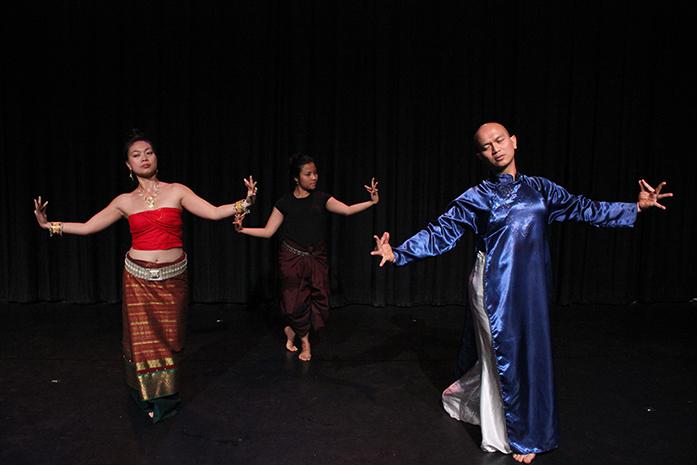By Isaac Hamlet
Soil, a comprehensive new work set to take the stage at Hancher this evening, was originally imagined a year ago by Michael Sakamoto, a University of Iowa assistant professor of dance, as a solo.
“[It was] exploring my own relationship to Asian identity,” he said. “As a fourth-generation Asian American, it’s always been a question for me for a number of reasons; one being the way Asians exist in American society. I think all Americans of color are trying to figure out what their place is and what their identity is.”
At 7:30 p.m. today, the Hancher audience will see the vision of Soil come to fruition. The dance performance, however, is no longer a solo. In fact, Sakamoto doesn’t perform in it at all.
When the project was still taking shape, Sakamoto realized he was tired of doing solos. Rather than make the show just about his experiences, he brought in another performer, Chey Chankethya, to make the piece a duet.
Even then, the project continued to morph.
“For whatever reason, the chemistry [between me and Chankethya] as performers us wasn’t really clicking,” Sakamoto said. “I thought, ‘Why don’t we make this a duet for two women instead? That’ll be a challenge for me to make a show about Asian females and identity.’ [Sirisook] was already there, so we brought her in. Then our friend Nguyen, who’s Vietnamese-American, came in, and he said, ‘That sounds great. I’d like to be in it, too.’”
Sakamoto stepped from stage and took on the role of director.
The three dancers performing in the final version come from three different backgrounds and styles of dance. Chankethya is a classical Cambodian dancer, Sirisook a traditional Thai dancer, and Nguyen — born in Vietnam but raised in America — tends toward contemporary Western dance.
Sakamoto said the show eventually evolved into a piece about Southeast Asia as a whole — “not just women but gender identity and also about a transnational identity as well.”
This transnational identity was explored by each of the dancers who choreographed their performances to match their experiences. Nguyen, for example, took a lens to Western dance not tending to accommodate his “Asian-ness.”
“Contemporary Western dance is not at all built around, culture, race, ethnicity, difference, any of that; it’s based on a set of concepts that have to do with everyday life, but that’s everyday life in America,” Sakamoto said. “It’s also very white. I don’t mean that in a positive or negative sense, I mean that in a cultural sense. This show was an opportunity for him to really push that tension, to choreograph and perform contemporary dance fully as an Asian.”
In Chankethya’s case, she decided to perform Hanuman the Monkey King, a role rigidly given to men in traditional Cambodian dance, but one Chankethya wanted to perform. For her iteration, she doesn’t don the garb typically adorning dancers who take the role. Instead, she’s performing the dance to a hip-hop track as herself.
Sakamoto describes sequence as an “expression of her own personal desire within this hermetic, rule-bound world of classical dance.”
“It’s a taboo [for her to do that],” Sirisook said. “So for her to break that and do the Monkey King, it’s a big deal. Even outside the country, it’s really brave of her.”
For Sirisook’s performance, she brings in traditional Thai headwear.
“Where I came from, traditional dance is very commercial,” she said. “We perform whatever the audience wants. So I have no shame in doing something very wrong.”
Through her performance, she carries the Thai headdress, not putting it on her head. In doing this, she is trying to convey the expectations of the nation she carries with her when she tells people she’s from Thailand.
“[Her performance] sort of represents the influence of Western culture,” Nguyen said. “In an interesting way, she’s taking the Western perception [of Asians], packaging it, and selling it back.”
People who learn she’s Thai expect her to be and behave a certain way. Just as according to Thai tradition it would be expected of her to perform wearing the headdress in the typical fashion. There’s a weight, a pressure.
“[Thailand] puts a significant feeling in [the headdress] — personally, I believe that it comes from trying to lift up or give the nation something to be proud of,” Sikisook said. “The headdress is how we say, this is our nation, and we are proud of that. I use it to show that once you’re not attached, once you’re willing to put it down, it’s just an object.”
This ability to inject so much of themselves — both on a personal and cultural level — into the performance is one of the things Sikisook enjoyed most.
“We have a plot, and we follow a story line, but everything, every single thing comes from our experience,” she said. “We really tell everyone in the audience who we are and where we come from, and it’s a gift to be able to do that.”
One of the more personal aspects of Nguyen’s performance comes from a solo dance he does based on traditional West African and Korean movements.
“He does this to a voiceover of a fictional letter he wrote to his father who was in a labor camp back in Vietnam,” Sakamoto said. “Which he really did as a kid, but this letter is fictionalized to encompass everything he was feeling in those years.”
While there are moments when dancers get solos, the experiences of these three people are presented on stage as a single show. Three different stories woven together to create a singular experience.
“Each of the performances is going straight into the contradictions in their practice and in their life,” Sakamoto said. “That’s what this show is about: viewing those beautiful and harsh realities of how they live their lives.”



